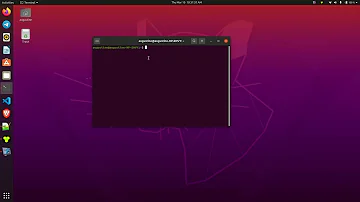How do I superuser in Linux terminal?
Creating a super user on a Linux operating systemCreate a user with security group permission. Issue the command: … Grant sudo permissions to the user for all commands. Note: By default, the sudo command requires user authentication before it runs a command. … Set the password for the newly created user.
How do I use superuser in terminal?
To run commands with superuser privileges, use the sudo command. sudo stands for superuser do. You're asked for the password of the current user. You're asked to enter the password for adminUsername, after which a new shell is opened for that user.

How do I sudo superuser?
4 Answers
- Run sudo <command> and type in your login password, if prompted, to run only that instance of the command as root. Next time you run another or the same command without the sudo prefix, you will not have root access.
- Run sudo -i . …
- Use the su (substitute user) command to get a root shell. …
- Run sudo -s .
What is the super user command?
The Unix command su, which stands for 'substitute user' (or historically 'superuser'), is used by a computer user to execute commands with the privileges of another user account. When executed it invokes a shell without changing the current working directory or the user environment.
What is command for being superuser or root user in Linux?
Log in as superuser on the system console. The pound sign (#) is the Bourne shell prompt for the superuser account. This method provides complete access to all system commands and tools. Log in as a user, and then change to the superuser account by using the su command at the command line.
How do I access superuser in Linux?
How to get root access on Linux operating system?
- Please click on the lower left corner of the icon (start button).
- Click Terminal menu item to open the terminal.
- Input the command below: % sudo su –
- Press Enter.
- Your terminal prompt will become #.
- You now have root privleges on all operations in the terminal window.
How do I find superuser in Linux?
Linux Login as Superuser Command
You need to use any one of the following command to log in as superuser or root user on Linux: su command – Run a command with substitute user and group ID in Linux. sudo command – Execute a command as another user on Linux.
How do I switch to root user?
Switching to the root user on my Linux server
- Enable root/admin access for your server.
- Connect via SSH to your server and run this command: sudo su –
- Enter your server password. You should now have root access.
How do I get to super user?
How to Become Superuser (root)
- Change to the superuser account by using the su command. % su Password: root_password # The pound sign (#) is the Bourne shell prompt for the superuser account.
- Log in as superuser on the system console. hostname console: root Password: root_password #
What is superuser in Linux?
On Linux, everything starts at "root." The hard drive has a root partition ( / ), and the default initial user (at least traditionally) is root (often referred to as the "superuser"). Historically, you used the root account to log in, create secondary "normal" users, and then mostly forget about it.
Is superuser the same as admin?
A superuser is an account with broad privileges, making it useful for system administration. This account is known by other names as well, such as “root”, “administrator”, and “supervisor”.
How do I enable superuser access?
To manage root permissions, open your app drawer and tap the SuperSU icon. You'll see a list of apps that have been granted or denied superuser access. You can tap on an app to change its permissions.
How do I login as root in Linux?
How to get root access on Linux operating system?
- Please click on the lower left corner of the icon (start button).
- Click Terminal menu item to open the terminal.
- Input the command below: % sudo su –
- Press Enter.
- Your terminal prompt will become #.
- You now have root privleges on all operations in the terminal window.
How do I enable root administrator?
In the server control page, click Settings. Next to Admin Access, click Change. Make sure Enable your admin (root and sudo) access permission is selected. Click Save, and then click OK.
How do I login as root in Linux terminal?
How to get root access on Linux operating system?
- Please click on the lower left corner of the icon (start button).
- Click Terminal menu item to open the terminal.
- Input the command below: % sudo su –
- Press Enter.
- Your terminal prompt will become #.
- You now have root privleges on all operations in the terminal window.
What is use of sudo su command in Linux?
The sudo command lets us use our account and password to execute system commands with root privileges, whereas the su command allows us to switch to a different user and execute one or more commands in the shell without logging out from our current session.
How do I switch to superuser in Linux?
There are two ways to become the superuser. The first is to log in as root directly. The second way is to execute the command su while logged in to another user account. The su command may be used to change one's current account to that of a different user after entering the proper password.
How do I become root user in Linux?
How to get root access on Linux operating system?
- Please click on the lower left corner of the icon (start button).
- Click Terminal menu item to open the terminal.
- Input the command below: % sudo su –
- Press Enter.
- Your terminal prompt will become #.
- You now have root privleges on all operations in the terminal window.
How do I change my user to Super admin?
Assign an admin role
- Sign in to your Google Admin console. …
- In the Admin console, go to Menu Directory. …
- Select the user you want to assign an admin role to.
- Click Admin roles and privileges.
- Next to the Super Admin role, click the slider so it's marked Assigned . …
- Click Save.
How do I enable superuser in Linux?
Creating a super user on a Linux operating system
- Create a user with security group permission. Issue the command: …
- Grant sudo permissions to the user for all commands. Note: By default, the sudo command requires user authentication before it runs a command. …
- Set the password for the newly created user.
How do I run as root user?
The sudo command allows you to run programs as another user, by default the root user. If the user is granted with sudo assess, the su command is invoked as root. Running sudo su – and then typing the user password has the same effect the same as running su – and typing the root password.
How to unlock root in Linux?
In order to unlock the root account, you have to use the “usermod” command with the “-U” and specify the root account.
How do I enable su to root?
If you want to use su , then you can run sudo passwd root and set the password you want to use to log in with su . This will also enable the root user as a full account user, however, so I don't recommend it. Instead, when you need persistent root privileges in that shell, use sudo su .
How do I activate root user?
, then enter an administrator name and password. To enable the root user, choose Edit > Enable Root User from the menu bar. Then enter the password that you want to use. You can then log in as the root user.
How do I access my super admin page?
Access your Page admin view:
- Tap your profile picture > Page name under Pages you manage (My pages module). Tap Show more to see more Page names.
- You'll be routed to your Super admin view, Content admin view, Curator view, or Analyst View, respectively.
How do I grant super admin access?
How do I give a user and user group super admin permissions?
- Select Permissions in the left navigation menu.
- From General > General Permissions > Who, choose the user or user group that needs super admin permissions. …
- Check Super administrator from Permissions.
- Select Save.


